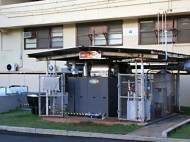MAGS – a new type of energy-efficient waste disposal system
 Large navy vehicles can carry several thousands of marines, making them little floating cities. In order to solve the problem with trash at remote forward operating bases (FOB) which burry or burn the waste. In partnership with the Office of Naval Research (ONR), Marines at Camp Smith, Hawaii, are testing a high-tech trash disposal system that reduces the security and logistics concerns of trash disposal, while helping the environment.
Large navy vehicles can carry several thousands of marines, making them little floating cities. In order to solve the problem with trash at remote forward operating bases (FOB) which burry or burn the waste. In partnership with the Office of Naval Research (ONR), Marines at Camp Smith, Hawaii, are testing a high-tech trash disposal system that reduces the security and logistics concerns of trash disposal, while helping the environment.
“What we are doing for FOBs can be applied to schools, hospitals or an office building”, said ”, said Donn Murakami, the U.S. Marine Corps Forces, Pacific science advisor who leads the Marine Corps’ evaluation team. “We are talking about disposing our waste in a different manner, rather than just sending it to the landfill.”
Micro Auto Gasification System (MAGS) is a controlled decomposition process which uses a controlled pyrolysis process to reduce the waste. Pyrolysis involves thermochemical decomposition of materials at high temperatures without the participation of oxygen. Although this process has been used for a while, MAGS compact design makes it suitable for both ships and shore facilities.
Developed by Terragon Environmental Technologies Inc. of Montréal, Canada, in collaboration with the ONR and the Canadian Department of National Defence, MAGS pyrolysis process achieves 750°C inside the insulated drum, and it destroys materials such as paper, cardboard, wood, plastic, chemicals, food, cloth, oils and grease, biological material, animal waste, agricultural waste, and sludge. A significant portion of the carbon is converted to char, preventing the buildup of carbon dioxide.
MAGS is capable to convert up to 40 kg (88 lbs) of solid waste and reduce it by as much as 95% by converting it into inert carbonaceous material and synthetic gas (syngas) that is used to sustain the process. The processing of that amount of waste lasts 2 hours, and it leaves the inorganic waste (such as glass and metal) intact and ready for recycling. The system is simple to operate and a unit can handle a continuous feed of waste stream for 500 to 1,000 Marines per day.
“Decades ago, the idea of harvesting energy from trash was just a side show in the environmental movement”, said Steve McElvany, the MAGS program officer at ONR. “Now, the technology is mature enough to where the Department of the Navy is seriously evaluating its practical and tactical benefits.”
MAGS has a low carbon footprint, and emissions which occur during the process are not visible, which is a tactical plus in military. Waste heat can also be used for practical purposes, such as heating living quarters or water. The system could be beneficial to civilians living on islands, where waste management represents a big problem.









Leave your response!